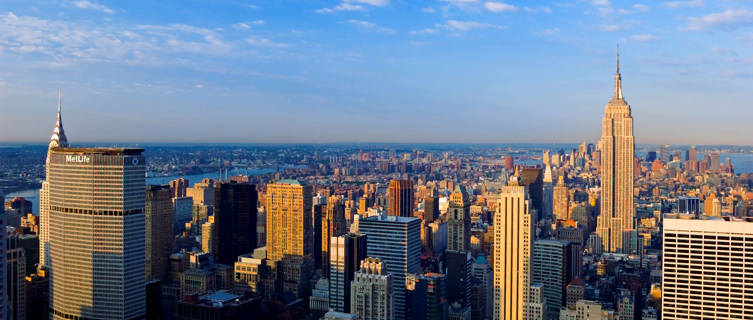City Overview of New York City
New York has always been a cosmopolitan city, and its multicultural residents, who speak over 80 languages together, give this mega-city an energy that is as lively and captivating as it is portrayed in numerous films.
With more than 18,000 restaurants, 150 world-class museums and over 10,000 shops selling brand names and goods from all over the world, New York has something for everyone. And far from the hustle and bustle of the urban jungle, there is also the relaxing oasis of Central Park, the Hudson River and the perfect relaxation destination Long Island. However, the epicenter of New York is still the island of Manhattan, which is surrounded by four other districts – The Bronx, Brooklyn, Queens and Staten Island.
Important facts
Area code: 212/917/718/646/347
Population: 8400000
Latitude: 40.714353
Longitude: -74.005973
Weather in New York City
New York is an excellent travel destination that has something to offer all year round. It is particularly pleasant here in spring and autumn, when the temperatures are around 21ºC. Winters are usually very unpredictable, there is often freezing cold and there are lashing storms. During the summer (until September) it is usually very muggy and oppressive.
City History of New York City
Rarely in the history of the world has a city been as dated as New York. The events of September 11, 2001 were incredible and catastrophic. The extent and consequences of this influence life in New York today and will continue to do so in the future. The aftermath of the terrorist destruction of New York’s two largest buildings, the Twin Towers – once symbols of the city’s confidence and success – penetrated all areas of life. Still, September 11th had little impact on New York’s vitality and appeal. The New Yorkers have shown defiant cohesion that is reflected everywhere, from the flags waving from the windows of almost every building to the patriotic stickers in the windshields of many cars.
Due to its location at the point where the Hudson River, the Bay of Long Island Sounds and the Atlantic meet, the city is of particular importance as a port and destination for millions of immigrants to the USA. The first European settlers on Manhattan were the Dutch in 1620, which gave the city the name New Amsterdam. In 1664 the British seized power and New Amsterdam became New York. The settlement spread to the north very quickly. 340 hectares were left as free land, and here Central Park was opened in 1876. Ten years later, New York’s most famous landmark, the Statue of Liberty on Ellis Island, was erected – a proud and triumphant symbol of freedom that was supposed to embody entry into the New World. On January 1, 1892, the Immigration Service was officially opened on Ellis Island, and in 1898 the five boroughs were combined into one “Greater New York”. Mass immigration has created several ethnic neighborhoods on the Manhattan Island.
Under the leadership of Mayor Rudolph Giuliani, New York experienced a kind of renaissance, and the city’s chronically high crime rate was reduced. Under Mayor Michael Bloomberg, New York was determined to overcome the worst terrorist attack in America’s history and continue the almost continuous progress and growth of one of the most fascinating cities in the world. So was built at Ground Zero : The National September 11 Memorial and Museum , also known as Reflecting Absence , is located where the twin towers once towered . Eyewitnesses report the attacks on the twin towers on September 11, 2001 at the 9/11 Tribute Center on Ground Zero . The One World Trade Center is right next to it . It is symbolic 1776 feet tall because in 1776 the United States declared independence from Britain.
Bill de Blasio has served as Mayor of New York City since November 2013.

